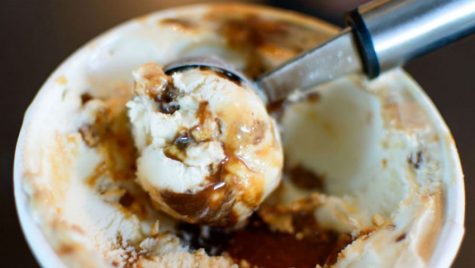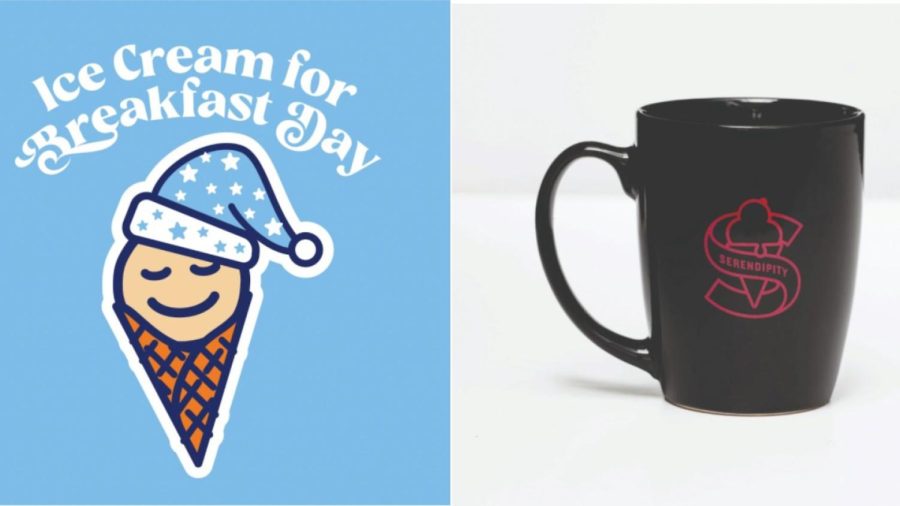A bit of Jewish ice cream history to get you ready for “Ice Cream for Breakfast Day”
Published February 1, 2023
Do you remember that wonderful feeling when you were little when your mom woke you up to tell you to go back to sleep because school was canceled due to snow? What a joy. Now imagine your mom was Mrs. Florence Rappaport of Rochester, N.Y. and there is a blizzard outside. Boy, would you be a happy kid. That’s because in 1966, Mrs. Rappaport let her children eat ice cream for breakfast on a snow day and that is why we celebrate “National Ice Cream for Breakfast Day” every first weekend of February.
“Ice cream is perfect for breakfast because it breaks up a monotonous cold winter with a little indoor fun,” said St. Louis ice cream entrepreneur Beckie Jacobs.
Jacobs and her Serendipity Homemade Ice Cream, now located in the Grove neighborhood, have been marking this special day for the past 15 years.
ADVERTISEMENT
“We didn’t create it but we are the first to celebrate in St. Louis. We go rain or snow or shine and have a lot planned for this year’s celebrations,” said Jacobs, who attends synagogue at Congregation Shaare Emeth.
“Ice Cream for Breakfast Day” is back
This year’s fun begins at Serendipity at 8 a.m. on Saturday, Feb. 4th. On the breakfast menu will be, for the first time, Waffle Sundaes on Waffle-licious Waffles, which are locally made hot Liège-style Belgian waffles topped with hot fudge, French toast, strawberries, maple bacon, cereal and milk.
“This year, we are also partnering with Pharaohs Donuts to bring you Dipity Dough Donut Ice Cream Sandwiches with your choice of any ice cream in the dip case,” said Jacobs.
And if you’re wearing PJs, you’ll receive a free mug filled with Kaldi’s or Firepot Tea or hot chocolate.
ADVERTISEMENT
“We recently received our liquor license, so we are celebrating with ‘wake up’ adult beverages,” said Jacobs. “We’ll be serving orange juice sorbet mimosas, Irish coffee, a hot toddy, or try a ‘Spirited Shake.’”
The surprising Jewish history of Haggen-Dazz

(The following was originally written by Joanna O’Leary and published with permission on Feb. 27, 2020)
Jewish entrepreneurs started some of the biggest names in the frozen treat industry: Chunky Monkey, Rum Tres Leches and Banana Nut Fudge.
Who gave the world the gift of these delectable ice cream flavor inventions?
While Italian immigrants are traditionally given credit for opening the first ice cream parlors in the United States in the early 20th century, a series of savvy Jewish entrepreneurs are responsible for the development of gourmet ice cream flavors and their subsequent rise in popularity among the general public.
The name Häagen-Dazs leads many to assume it is Nordic in origin. Surprise — this internationally renowned ice cream company that has over $2 billion in sales annually was actually the brainchild of a Polish Jew named Reuben Mattus. Just after immigrating to America in the 1920s at the age of 10, along with his widowed mother, Mattus went to work for his uncle’s Italian lemon ice business in Brooklyn. By the early 1930s, the family had expanded its product line to include chocolate-covered ice cream bars, ice cream pops and ice cream sandwiches.
Mattus was convinced he could deliver even higher quality ice cream to his customers and engaged in a thorough self-education on the science and culinary methodology required to create the richest, most superior frozen confections. Mattus’ real stroke of genius, however, was his recognition that his new ultra-premium ice cream needed a certain cosmopolitan cachet to make it appeal to his target audience: sophisticated, moneyed Americans. Thus he decided to give it a “foreign-sounding” name, specifically a Danish(ish) one to pay tribute to the country’s effort to save Jews during World War II.
Remarkably, at about the same time, another Jewish entrepreneur on the other side of the country was launching his own ice cream experiment. Irv Robbins, a Canadian, was self-taught, first gaining skills working in his father’s store and then teaching himself more advanced techniques while crafting ice cream as a lieutenant in the U.S. Navy during WWII. In 1945, Robbins opened the Snowbird Ice Cream parlor, in part with funds from his bar mitzvah (how’s that for foresight?) in Glendale, Calif., and quickly won rave reviews for the wide variety of flavors. Shortly thereafter, Robbins’ brother-in-law Bert Baskin opened his own shop, and in 1948, the fraternal pair established a joint establishment and soon-to-be company Baskin-Robbins.
They came full circle when, nearly 50 years later, Baskin-Robbins merged with Dunkin’ Donuts — founded by the Jewish entrepreneur William Rosenberg.
Steve Herrell, whose spouse and business partner was Jewish, observed the strides made by Häagen-Dazs in broadening consumers’ tastes for ice cream and decided to capitalize on that momentum by opening an ice cream shop in the 1970s that proffered flavors more exotic than the standard chocolate, vanilla and strawberry. Located in Somerville, Mass., Herrell served then-novel varieties of creams such as chocolate pudding, cookie dough and peanut butter, as well as afforded customers the opportunity to add “mix-ins” like M&Ms, chocolate sandwich cookies, sprinkles and toffee bits.
And just as Herrell was inspired by Häagen-Dazs, his ice cream innovations would influence other ice cream entrepreneurs, including two mensches who would arguably go on to become America’s greatest creators and purveyors of gourmet ice cream: Ben (Cohen) & Jerry (Greenfield).
After witnessing firsthand Herrell perform his mix-in technique at his eponymous parlor, the dynamic duo started their scoop shop in 1978 in Burlington, Vermont. They initially followed Herrell’s style of manually incorporating different toppings, then moved on to churning out pints pre-blended with different candies, baked goods and sauces, thus paving the way for the emergence of Phish Food, Chubby Hubby and other iconic Ben & Jerry’s flavors.
When it comes to ice cream, how sweet it is to be loved by Jews.
This story originally appeared on The Nosher.

















